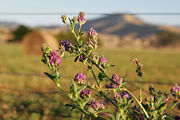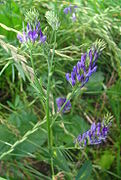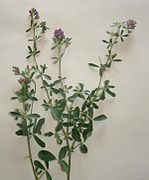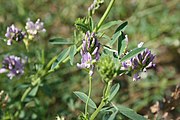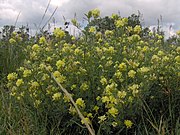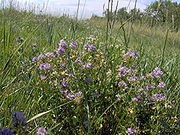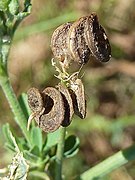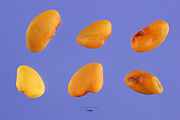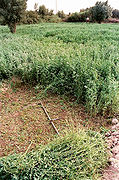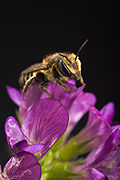Alfalfa: Difference between revisions
m Adding citation for British usage of "lucerne". |
|||
| Line 223: | Line 223: | ||
{{commons|Medicago sativa}} |
{{commons|Medicago sativa}} |
||
{{wikispecies|Medicago sativa}} |
{{wikispecies|Medicago sativa}} |
||
* '''[http://www.cwrdiversity.org/checklist/genepool-details.php?id%5B%5D=29&id%5B%5D=290& Crop Wild Relatives Inventory]''' for ''Medicago sativa'' genepool: reliable information source on where and what to conserve ex-situ |
|||
* [http://www.fao.org/ag/AGP/AGPC/doc/Gbase/DATA/Pf000346.htm Grassland Species profile] |
* [http://www.fao.org/ag/AGP/AGPC/doc/Gbase/DATA/Pf000346.htm Grassland Species profile] |
||
* [http://www.alfalfa.org/ National Alfalfa Alliance] |
* [http://www.alfalfa.org/ National Alfalfa Alliance] |
||
Revision as of 18:38, 20 August 2013
- Alphalpha leads here. For other uses of the word, see Alphalpha (disambiguation)
| Alfalfa | |
|---|---|
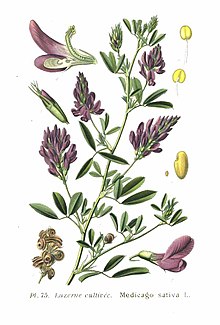
| |
| Medicago sativa | |
| Scientific classification | |
| Kingdom: | |
| (unranked): | |
| (unranked): | |
| (unranked): | |
| Order: | |
| Family: | |
| Genus: | |
| Species: | M. sativa
|
| Binomial name | |
| Medicago sativa | |
| Subspecies | |
| Synonyms[2] | |
|
List of Synonyms
| |
Alfalfa /ælˈfælfə/, Medicago sativa, also called lucerne, is a perennial flowering plant in the pea family Fabaceae cultivated as an important forage crop in many countries around the world. The English name alfalfa is widely used, particularly in North America. But in the UK,[3] Australia, South Africa and New Zealand, the more commonly used name is lucerne. It superficially resembles clover, with clusters of small purple flowers followed by fruits spiralled in 2 to 3 turns containing 10-20 seeds. Alfalfa is native to a warmer temperate climate such as that of Iran (where it is thought to have originated). It has been cultivated as livestock fodder since at least the era of the ancient Greeks and Romans.
Ecology
Alfalfa is a perennial forage legume which normally lives four to eight years, but can live more than 20 years, depending on variety and climate.[4] The plant grows to a height of up to 1 m (3 ft), and has a deep root system, sometimes stretching more than 15 m (49 ft).[4] This makes it very resilient, especially to droughts.[4] It has a tetraploid genome.[5]
Alfalfa is a small-seeded crop, and has a slowly growing seedling, but after several months of establishment, forms a tough 'crown' at the top of the root system. This crown contains many shoot buds that enables alfalfa to regrow many times after being grazed or harvested.
This plant exhibits autotoxicity, which means it is difficult for alfalfa seed to grow in existing stands of alfalfa.[6] Therefore, alfalfa fields are recommended to be rotated with other species (for example, corn or wheat) before reseeding.[7]
Culture
Alfalfa is widely grown throughout the world as forage for cattle, and is most often harvested as hay, but can also be made into silage, grazed, or fed as greenchop.[8] Alfalfa usually has the highest feeding value of all common hay crops. It is used less frequently as pasture.[7] When grown on soils where it is well-adapted, alfalfa is often the highest-yielding forage plant, but its primary benefit is the combination of high yield per hectare and high nutritional quality.[9]
Its primary use is as feed for high-producing dairy cows, because of its high protein content and highly digestible fiber, and secondarily for beef cattle, horses, sheep, and goats.[10][11] Humans also eat alfalfa sprouts in salads and sandwiches.[12][13] Dehydrated alfalfa leaf is commercially available as a dietary supplement in several forms, such as tablets, powders and tea.[14] Alfalfa can cause bloating in livestock, so care must be taken with livestock grazing on alfalfa because of this hazard.[15]
Like other legumes, its root nodules contain bacteria, Sinorhizobium meliloti, with the ability to fix nitrogen, producing a high-protein feed regardless of available nitrogen in the soil.[16] Its nitrogen-fixing ability (which increases soil nitrogen) and its use as an animal feed greatly improve agricultural efficiency.[17][18]
Alfalfa can be sown in spring or fall, and does best on well-drained soils with a neutral pH of 6.8 – 7.5.[19][20] Alfalfa requires sustained levels of potassium and phosphorus to grow well.[21] It is moderately sensitive to salt levels in both the soil and irrigation water, although it continues to be grown in the arid southwestern United States, where salinity is an emerging issue.[22][23][24] Soils low in fertility should be fertilized with manure or a chemical fertilizer, but correction of pH is particularly important.[25] Usually a seeding rate of 13 – 20 kg/hectare (12 – 25 lb/acre) is recommended, with differences based upon region, soil type, and seeding method.[26] A nurse crop is sometimes used, particularly for spring plantings, to reduce weed problems and soil erosion, but can lead to competition for light, water, and nutrients.[27]
In most climates, alfalfa is cut three to four times a year, but it can be harvested up to 12 times per year in Arizona and southern California.[28][29] Total yields are typically around eight tonnes per hectare (four short tons per acre) in temperate environments, but yields have been recorded up to 20 t/ha (16 ts per acre).[29] Yields vary with region, weather, and the crop's stage of maturity when cut. Later cuttings improve yield, but with reduced nutritional content.[30]
Beneficial insects
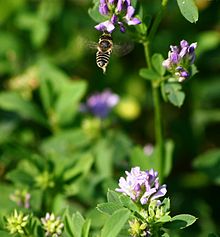
Alfalfa is considered an insectary, a place where insects are reared, and has been proposed as helpful to other crops, such as cotton, if the two are interplanted, because the alfalfa harbours predatory and parasitic insects that would protect the other crop.[31] Harvesting the alfalfa by mowing the entire crop area destroys the insect population, but this can be avoided by mowing in strips so that part of the growth remains.[31]
Pests and diseases
Like most plants, alfalfa can be attacked by various pests and pathogens. Diseases often have subtle symptoms which are easily misdiagnosed and can affect leaves, roots, and stems.
Some pests, such as the alfalfa weevil, aphids, armyworms, and the potato leafhopper, can reduce alfalfa yields dramatically, particularly with the second cutting when weather is warmest.[32] Chemical controls are sometimes used to prevent this.[32] Alfalfa is also susceptible to root rots, including Phytophthora, Rhizoctonia, and Texas root rot.[33][34][35]
Harvesting


When alfalfa is to be used as hay, it is usually cut and baled.[36] Loose haystacks are still used in some areas, but bales are easier for use in transportation, storage, and feed.[37] Ideally, the first cutting should be taken at the bud stage, and the subsequent cuttings just as the field is beginning to flower, or one-tenth bloom because carbohydrates are at their highest.[38] When using farm equipment rather than hand-harvesting, a swather cuts the alfalfa and arranges it in windrows.[39] In areas where the alfalfa does not immediately dry out on its own, a machine known as a mower-conditioner is used to cut the hay.[36] The mower-conditioner has a set of rollers or flails that crimp and break the stems as they pass through the mower, making the alfalfa dry faster.[40] After the alfalfa has dried, a tractor pulling a baler collects the hay into bales.
Several types of bales are commonly used for alfalfa. For small animals and individual horses, the alfalfa is baled into small, two-string bales, commonly named by the strands of string used to wrap it. Other bale sizes are three-string, and so on up to half-ton (six-string) "square" bales – actually rectangular, and typically about 40 x 45 x 100 cm (14 x 18 x 38 in).[5] Small square bales weigh from 25–30 kg (50–70 lb) depending on moisture, and can be easily hand separated into "flakes". Cattle ranches use large round bales, typically 1.4 to 1.8 m (4 to 6 ft) in diameter and weighing from 500 to 1,000 kg, (1000 to 2000 lbs). These bales can be placed in stable stacks or in large feeders for herds of horses, or unrolled on the ground for large herds of cattle.[5] The bales can be loaded and stacked with a tractor using a spike, known as a bale spear, that pierces the center of the bale,[41] or they can be handled with a grapple (claw) on the tractor's front-end loader. A more recent innovation is large "square" bales, roughly the same proportions as the small squares, but much larger. The bale size was set so stacks would fit perfectly on a large flatbed truck. These are more common in the western United States.
When used as feed for dairy cattle, alfalfa is often made into haylage by a process known as ensiling.[10] Rather than drying it to make dry hay, the alfalfa is chopped finely and fermented in silos, trenches, or bags, where the oxygen supply can be limited to promote fermentation.[42][dead link] The anaerobic fermentation of alfalfa allows it to retain high nutrient levels similar to those of fresh forage, and is also more palatable to dairy cattle than dry hay.[43] In many cases, alfalfa silage is inoculated with different strains of microorganisms to improve the fermentation quality and aerobic stability of the silage.[44]
Worldwide production

Alfalfa is the most cultivated forage legume in the world.[citation needed] Worldwide production was around 436 million tons in 2006.[45][page needed] In 2009, alfalfa was grown on approximately 30 million hectares (74,000,000 acres) worldwide; of this North America produced 41% (11.9 million hectares; 29,000,000 acres), Europe produced 25% (7.12 million hectares; 17,600,000 acres), South America produced 23% (7 million hectares; 17,000,000 acres), Asia produced 8% (2.23 million hectares; 5,500,000 acres), and Africa and Oceania produced the remainder.[46] The US was the largest alfalfa producer in the world by area in 2009, with 9 million hectares (22,000,000 acres), but considerable production area is found in Argentina (6.9 million hectares; 17,000,000 acres), Canada (2 million hectares; 4,900,000 acres), Russia (1.8 million hectares; 4,400,000 acres), Italy (1.3 million hectares; 3,200,000 acres), and China (1.3 million hectares; 3,200,000 acres).[46]
United States
In the United States in 2012, the leading alfalfa-growing states were California, Idaho, and Montana.[47] Alfalfa is predominantly grown in the northern and western United States;[47] it can be grown in the southeastern United States, but leaf and root diseases, poor soils, and a lack of well-adapted varieties are often limitations.[48]
Alfalfa and bees
Alfalfa seed production requires the presence of pollinators when the fields of alfalfa are in bloom.[5] Alfalfa pollination is somewhat problematic, however, because western honey bees, the most commonly used pollinator, are not suitable for this purpose; the pollen-carrying keel of the alfalfa flower trips and strikes pollinating bees on the head, which helps transfer the pollen to the foraging bee.[5] Western honey bees, however, do not like being struck in the head repeatedly and learn to defeat this action by drawing nectar from the side of the flower. The bees thus collect the nectar, but carry no pollen, so do not pollinate the next flower they visit.[49] Because older, experienced bees do not pollinate alfalfa well, most pollination is accomplished by young bees that have not yet learned the trick of robbing the flower without tripping the head-knocking keel. When western honey bees are used to pollinate alfalfa, the beekeeper stocks the field at a very high rate to maximize the number of young bees.[49] Western honey bee colonies may suffer protein stress when working alfalfa only, due to shortage of one of the amino acids comprising the pollen protein, isoleucine. Today, the alfalfa leafcutter bee is increasingly used to circumvent these problems.[50] As a solitary but gregarious bee species, it does not build colonies or store honey, but is a very efficient pollinator of alfalfa flowers.[50] Nesting is in individual tunnels in wooden or plastic material, supplied by the alfalfa seed growers.[49] The leafcutter bees are used in the Pacific Northwest, while western honeybees dominate in California alfalfa seed production.[49]
A smaller amount of alfalfa produced for seed is pollinated by the alkali bee, mostly in the northwestern United States. It is cultured in special beds near the fields. These bees also have their own problems. They are not portable like honey bees, and when fields are planted in new areas, the bees take several seasons to build up.[49] Honey bees are still trucked to many of the fields at bloom time.
Varieties

Considerable research and development has been done with this important plant. Older cultivars such as 'Vernal' have been the standard for years, but many better public and private varieties better adapted to particular climates are available.[51] Private companies release many new varieties each year in the US.[52]
Most varieties go dormant in the fall, with reduced growth in response to low temperatures and shorter days.[52] 'Nondormant' varieties that grow through the winter are planted in long-seasoned environments such as Mexico, Arizona, and Southern California, whereas 'dormant' varieties are planted in the Upper Midwest, Canada, and the Northeast.[52] 'Nondormant' varieties can be higher-yielding, but they are susceptible to winter-kill in cold climates and have poorer persistence.[52]
Most alfalfa cultivars contain genetic material from sickle medick (M. falcata), a wild variety of alfalfa that naturally hybridizes with M. sativa to produce sand lucerne (M. sativa ssp. varia). This species may bear either the purple flowers of alfalfa or the yellow of sickle medick, and is so called for its ready growth in sandy soil.[53]

Most of the improvements in alfalfa over the last decades have consisted of better disease resistance on poorly drained soils in wet years, better ability to overwinter in cold climates, and the production of more leaves. Multileaf alfalfa varieties have more than three leaflets per leaf, giving them greater nutritional content by weight because there is more leafy matter for the same amount of stem.[citation needed]
The L. Teweles Seed Company claimed it created the world's first hybrid alfalfa.[54]
Wisconsin and California and many other states publish alfalfa variety trial data. A complete listing of state variety testing data is provided by the North American Alfalfa Improvement Conference (NAAIC) State Listing, as well as additional detailed alfalfa genetic and variety data published by NAAIC.
Genetically modified alfalfa
Roundup Ready alfalfa, a genetically modified variety was released by Forage Genetics International in 2005. This was developed through the insertion of a gene owned by Monsanto Company that confers resistance to glyphosate, a broad-spectrum herbicide, also known as Roundup. Although most grassy and broadleaf plants, including ordinary alfalfa, are killed by Roundup, growers can spray fields of Roundup Ready alfalfa with the glyphosate herbicide and kill the weeds without harming the alfalfa crop.
Legal issues with Roundup Ready alfalfa in the US
In 2005, after completing a 28-page environmental assessment (EA)[55] the United States Department of Agriculture (USDA) granted Roundup Ready alfalfa (RRA) nonregulated status[56] under Code of Federal Regulations Title 7 Part 340,[57] called, "Introduction of Organisms and Products Altered or Produced Through Genetic Engineering Which Are Plant Pests or Which There Is Reason to Believe Are Plant Pests", which regulates, among other things, the introduction (importation, interstate movement, or release into the environment) of organisms and products altered or produced through genetic engineering that are plant pests or that there is reason to believe are plant pests. Monsanto had to seek deregulation to conduct field trials of RRA, because the RRA contains a promoter sequence derived from the plant pathogen figwort mosaic virus.[55] The USDA granted the application for deregulation, stating that the RRA with its modifications: "(1) Exhibit no plant pathogenic properties; (2) are no more likely to become weedy than the nontransgenic parental line or other cultivated alfalfa; (3) are unlikely to increase the weediness potential of any other cultivated or wild species with which it can interbreed; (4) will not cause damage to raw or processed agricultural commodities; (5) will not harm threatened or endangered species or organisms that are beneficial to agriculture; and (6) should not reduce the ability to control pests and weeds in alfalfa or other crops."[55] Monsanto started selling RRA and within two years, more than 300,000 acres were devoted to the plant in the US.[58]
The granting of deregulation was opposed by many groups, including growers of non-GM alfalfa who were concerned about gene flow into their crops.[55] In 2006, the Center for Food Safety, a US non-governmental organization that is a critic of biotech crops, and others, challenged this deregulation in the California Northern District Court[59] Organic growers were concerned that the GM alfalfa could cross-pollinate with their organic alfalfa, making their crops unsalable in countries that ban the growing of GM crops.[60] The District Court ruled that the USDA's EA did not address two issues concerning RRA's effect on the environment[61] and in 2007, required the USDA to complete a much more extensive environmental impact statement (EIS). Until the EIS was completed, they banned further planting of RRA but allowed land already planted to continue.[58][62] The USDA proposed a partial deregulation of RRA but this was also rejected by the District Court.[59] Planting of RRA was halted.
In June 2009, a divided three-judge panel on the 9th U.S. Circuit Court of Appeals upheld Breyer's decision.[63] Monsanto and others appealed to the US Supreme Court[63]
On 21 June 2010, in Monsanto Co. v. Geertson Seed Farms, the Supreme Court overturned the District Court decision to ban planting RRA nationwide as there was no evidence of irreparable injury.[64] They ruled that the USDA could partially deregulate RRA before an EIS was completed. The Supreme Court did not consider the District Court's ruling disallowing RRA's deregulation and consequently RRA was still a regulated crop waiting for USDA's completion of an EIS.[59]
This decision was welcomed by the American Farm Bureau Federation, Biotechnology Industry Organization, American Seed Trade Association, American Soybean Association, National Alfalfa and Forage Alliance, National Association of Wheat Growers, National Cotton Council, and National Potato Council.[65] In July 2010, 75 members of Congress from both political parties sent a letter to Vilsack asking him to immediately allow limited planting of genetically engineered alfalfa.[66][67] However the USDA did not issue interim deregulatory measures, instead focusing on completing the EIS. Their 2,300-page EIS was published in December 2010.[68] It concluded that RRA would not affect the environment.
Three of the biggest natural food brands in the USA lobbied for a partial deregulation of RRA,[69] but in January 2011, despite protests from organic groups, Agriculture Secretary Tom Vilsack announced that the USDA had approved the unrestricted planting of genetically modified alfalfa and planting resumed.[70][71][72] Secretary Vilsack commented, "After conducting a thorough and transparent examination of alfalfa ... APHIS [Animal and Plant Health Inspection Service] has determined that Roundup Ready alfalfa is as safe as traditionally bred alfalfa."[73] About 20 million acres (8 million hectares) of alfalfa were grown in the US, the fourth-biggest crop by acreage, of which about 1% were organic. Some biotechnology officials forecast that half of the US alfalfa acreage could eventually be planted with GM alfalfa.[74]
The National Corn Growers Association,[75] the American Farm Bureau Federation,[76] and the Council for Biotech Information[77] warmly applauded this decision. Christine Bushway, CEO of the Organic Trade Association said, "A lot of people are shell-shocked. While we feel Secretary Vilsack worked on this issue, which is progress, this decision puts our organic farmers at risk."[74] The Organic Trade Association issued a press release in 2011 saying that the USDA recognized the impact that cross-contamination could have on organic alfalfa and urged them to place restrictions to minimize any such contamination.[78] However, organic farming groups, organic food outlets, and activists responded by publishing an open letter saying that planting the "alfalfa without any restrictions flies in the face of the interests of conventional and organic farmers, preservation of the environment, and consumer choice."[79] Senator Debbie Stabenow, Chairwoman of the Senate Agriculture Committee,[80] House Agriculture Committee Chairman Frank Lucas[80] and Senator Richard Lugar [81] issued statements strongly supporting the decision "...giving growers the green light to begin planting an abundant, affordable and safe crop" and giving farmers and consumers the choice ... in planting or purchasing food grown with GM technology, conventionally, or organically." In a Joint Statement, US Senator Patrick Leahy and Representative Peter DeFazio said the USDA had the "opportunity to address the concerns of all farmers", but instead "surrender[ed] to business as usual for the biotech industry."[82]
The Center for Food Safety appealed this decision in March 2011[83][84] but the District Court for Northern California rejected this motion in 2012.[85]
History
Alfalfa seems to have originated in south-central Asia, and was first cultivated in Persia.[86][87] It was introduced to Greece in about 490 BC when the Persians invaded, as fodder for the army's cattle and horses, and from there was introduced to Italy in the first century AD.[86][87] Alfalfa is briefly mentioned in the fourth century AD book Opus Agriculturae by Palladius, stating: "One sow-down lasts ten years. The crop may be cut four or six times a year ... A jugerum of it is abundantly sufficient for three horses all the year ... It may be given to cattle, but new provender is at first to be administered very sparingly, because it bloats up the cattle."[88] Palladius called alfalfa medica, a name that referred to the Medes, a people who lived in ancient Iran. The ancient Greeks and Romans believed, probably correctly, that alfalfa came from the Medes, in today's Iran. (The ancient Greeks and Romans also used the name medica to mean a citron fruit, once again because it was believed to have come from the Medes land). This name is the root of the modern scientific name for the alfalfa genus, Medicago. Despite the report in Opus Agriculturae and in some other Roman and ancient Greek writers, there is little evidence that alfalfa was in widespread use in the Mediterranean region in those days.[citation needed]
Alfalfa was introduced to Spain in the eighth century during the Umayyad conquest of Hispania.[86][87] The medieval Arabic agricultural writer Ibn al-'Awwam, who lived in Spain in the later 12th century, discussed how to sow and cultivate alfalfa, which he called الفصفصة (al-fáṣfaṣa, "the best fodder"),[89] and a 13th-century general-purpose Arabic dictionary, Lisān al-'Arab, says that alfalfa was cultivated as an animal feed and consumed in both fresh and dried forms.[90] It is from the Arabic al-fáṣfaṣa that the Spanish alfalfa was derived.[91][92][93] In the 16th century, Spanish colonizers introduced alfalfa to the western Americas as fodder for their horses.[87] Alfalfa seeds were imported to California from Chile in the 1850s, beginning a rapid and extensive introduction of the crop over the western US States[86] and introducing the word "alfalfa" to the English language. In the North American colonies of the eastern US in the 18th century, it was called "lucerne", and many trials at growing it were made. Its needs weren't well understood, and early attempts at growing it failed;[87] relatively little alfalfa is grown in the southeastern United States today.[47] "Lucerne" is the name currently used for alfalfa in France, Germany, Britain, and Australia, and arose in the 16th century from the Provençal luzerno ("glow worm"), due to its shiny seeds.[94][95] Since North and South America now produce a large part of the world's output, the word "alfalfa" has been slowly entering other languages.
Phytoestrogens in alfalfa
Alfalfa, like other leguminous crops, is a known source of phytoestrogens,[96] including spinasterol,[97] coumestrol, and coumestan.[98] Because of this, grazing on alfalfa has caused reduced fertility in sheep and in dairy cattle.[98]
Nutritional value
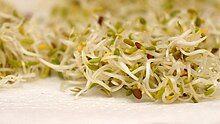
Alfalfa is high in protein, calcium and other minerals, vitamins in the B group, vitamin C, vitamin D, vitamin E, and vitamin K.[99][100][101][102] The sun-dried hay of alfalfa has been found to be a source of vitamin D, containing 48 ng/g (1920 IU/kg) vitamin D2 and 0.63 ng/g (25 IU/kg) vitamin D3.[103] There is reference to vitamin D2 and vitamin D3 being found in the alfalfa shoot; this is awaiting verification.[104] Mushrooms are not allowed in Jain vegetarianism, making alfalfa the only known source Jains can use to make vitamin D2 supplements.
Sprouting
| Nutritional value per 100 g (3.5 oz) | |||||||||||||||||||||||||||||||||||||||||||||
|---|---|---|---|---|---|---|---|---|---|---|---|---|---|---|---|---|---|---|---|---|---|---|---|---|---|---|---|---|---|---|---|---|---|---|---|---|---|---|---|---|---|---|---|---|---|
| Energy | 96 kJ (23 kcal) | ||||||||||||||||||||||||||||||||||||||||||||
2.1 g | |||||||||||||||||||||||||||||||||||||||||||||
| Dietary fiber | 1.9 g | ||||||||||||||||||||||||||||||||||||||||||||
0.7 g | |||||||||||||||||||||||||||||||||||||||||||||
4 g | |||||||||||||||||||||||||||||||||||||||||||||
| |||||||||||||||||||||||||||||||||||||||||||||
| †Percentages estimated using US recommendations for adults,[105] except for potassium, which is estimated based on expert recommendation from the National Academies.[106] | |||||||||||||||||||||||||||||||||||||||||||||
Sprouting alfalfa seeds is the process of germinating seeds for consumption usually involving just water and a jar. Sprouting alfalfa usually takes three to four days with one tablespoon of seed yielding up to three full cups of sprouts.[107]
Traditional medicine
Alfalfa has been used as an herbal medicine for over 1,500 years.[citation needed] In early Chinese medicines, physicians used young alfalfa leaves to treat disorders related to the digestive tract and the kidneys.[citation needed] In Ayurvedic medicine, physicians used the leaves for treating poor digestion.[citation needed] They made a cooling poultice from the seeds for boils. At the time, alfalfa was also believed to be beneficial to people suffering from arthritis and water retention.[citation needed]
Gallery
References
- ^ "Medicago sativa – ILDIS LegumeWeb". ildis.org. Retrieved 7 March 2008.
- ^ "The Plant List: A Working List of All Plant Species".
- ^ "Definition of lucerne in English". Oxford Dictionaries. Retrieved 10 August 2013.
- ^ a b c "alfalfa (plant) – Britannica Online Encyclopedia". Britannica.com. Archived from the original on 7 June 2011. Retrieved 29 June 2011.
{{cite web}}: Unknown parameter|deadurl=ignored (|url-status=suggested) (help) - ^ a b c d e "CELL BIOLOGY & MOLECULAR GENETICS" (PDF). Ddr.nal.usda.gov. Retrieved 19 April 2013.
- ^ "Understanding Autotoxicity in Alfalfa". Uwex.edu. Archived from the original on 14 June 2011. Retrieved 29 June 2011.
{{cite web}}: Unknown parameter|deadurl=ignored (|url-status=suggested) (help) - ^ a b "SUSTAINABLE AGRICULTURE MANAGEMENT GUIDES" (PDF). Kansas Rural Center. Retrieved 19 April 2013.
- ^ "Alfalfa in the South" (PDF). Caf.wvu.edu. Retrieved 19 April 2013.
- ^ "A" (PDF). UKY. Retrieved 19 April 2013.
- ^ a b "Alfalfa for Dairy Cattle" (PDF). Uaex.edu. Retrieved 19 April 2013.
- ^ "HayUSA,INC. Premium Quality – Alfalfa". Hayusa.net. Archived from the original on 23 July 2011. Retrieved 29 June 2011.
{{cite web}}: Unknown parameter|deadurl=ignored (|url-status=suggested) (help) - ^ Spottiswood, John. "Alfalfa sprouts". CookEatShare. Archived from the original on 8 July 2011. Retrieved 29 June 2011.
{{cite web}}: Unknown parameter|deadurl=ignored (|url-status=suggested) (help) - ^ "Alfalfa for Industrial and Other Uses" (PDF). Alfalfa.ucdavis.edu. Retrieved 19 April 2013.
- ^ "Alfalfa: MedlinePlus Supplements". Nlm.nih.gov. Retrieved 29 June 2011.
- ^ Medicago Sativa (Alfalfa). Plantdex.com. Retrieved on 17 October 2011.
- ^ "Sinorhizobium meliloti genome home". Cmgm.stanford.edu. Archived from the original on 19 May 2011. Retrieved 29 June 2011.
{{cite web}}: Unknown parameter|deadurl=ignored (|url-status=suggested) (help) - ^ "Nitrogen Fixation in Crop Production" (PDF). portal.sciencesocities.org. Retrieved 19 April 2013.
- ^ "Commodity Fact Sheet Alfalfa Information compiled by the California Alfalfa and Forage Association" (PDF). Alfalfa.ucdavis.edu. Retrieved 19 April 2013.
- ^ "UCANR Web Sites". Cestanislaus.ucdavis.edu. Archived from the original on 17 July 2011. Retrieved 29 June 2011.
{{cite web}}: Unknown parameter|deadurl=ignored (|url-status=suggested) (help) - ^ http://forageresearch.tamu.edu/1985/CloverEstablishmentGrowth.pdf
- ^ "Phosphorus and Potassium Fertilization of Alfalfa" (PDF). Ces.purdue.edu. Retrieved 19 April 2013.
- ^ G4555 Managing Manure on Alfalfa Hay | University of Missouri Extension. Extension.missouri.edu. Retrieved on 17 October 2011.
- ^ "New Findings on Salinity in Streams and Ground Water in the Southwestern United States" (PDF). Water.usgs.gov. Retrieved 19 April 2013.
- ^ "Growing Alfalfa for Seed in Arizona" (PDF). Ag.arizona.edu. Retrieved 19 April 2013.
- ^ Fertilizing Alfalfa in Minnesota. Extension.umn.edu. Retrieved on 17 October 2011.
- ^ Alfalfa seeding rates: how much is too much?. Uwex.edu. Retrieved on 17 October 2011.
- ^ MT200504.indd. (PDF) . Retrieved on 17 October 2011.
- ^ Alfalfa Cutting Height. Uwex.edu (9 April 1999). Retrieved on 17 October 2011.
- ^ a b [1][dead link]
- ^ Alfalfa: The High-Quality Hay for Horses. (PDF) . Retrieved on 17 October 2011.
- ^ a b Thomas F. Leigh (undated). ref "Alfalfa as an insectary for beneficial insects".
{{cite web}}: Check|url=value (help); Check date values in:|date=(help) - ^ a b Insect Pest Management on Alfalfa, FC-ENT-0031-00. Ohioline.osu.edu. Retrieved on 17 October 2011.
- ^ Phytophthora Root Rot of Alfalfa Key words: Plant Disease, Lucerne, black medic, birdsfoot trefoil, Phytophthora megasperma F. sp. medicaginis. Nu-distance.unl.edu (26 February 1997). Retrieved on 17 October 2011.
- ^ Rhizoctonia Root, Stem, and Crown Rot of Alfalfa AC-42-96. Ohioline.osu.edu. Retrieved on 17 October 2011.
- ^ "Phymatotrichum Root Rot" (PDF). Pods.dasnr.okstate.edu. Retrieved 19 April 2013.
- ^ a b "Har vesting Alfalfa Hay" (PDF). Uaex.edu. Retrieved 19 April 2013.
- ^ G4570 Reducing Losses when Feeding Hay to Beef Cattle | University of Missouri Extension. Extension.missouri.edu. Retrieved on 17 October 2011.
- ^ Alfalfa Management Guide—Harvest (3 of 3). (PDF) . Retrieved on 17 October 2011.
- ^ Hay harvesting by Self-Propelled Swather compared with mowing and raking. (PDF) . Retrieved on 17 October 2011.
- ^ hay mower-conditioner (agriculture) – Britannica Online Encyclopedia. Britannica.com. Retrieved on 17 October 2011.
- ^ Washburn Company Auger, Hay bale spear & attachments, Grain Equipment, Fence Line Mower
- ^ http://ucanr.org/alf_symp/1995/95-55.pdf
- ^ [2][dead link]
- ^ "The Ensiling Process and Additives" (PDF). Extension.iastate.edu. Retrieved 19 April 2013.
- ^ FAO, 2006. FAOSTAT-Food and Agriculture Organization of the United Nations. Faostat.fao.org. Retrieved on 17 October 2011.
- ^ a b Cash, Dennis, ed. (2009). "Chapter 1. Global Status and Development Trends of Alfalfa". Alfalfa Management Guide for Ningxia (PDF). United Nations Food and Agriculture Organization. pp. 1–2. Retrieved 3 August 2013.
{{cite book}}: External link in|chapterurl=|chapterurl=ignored (|chapter-url=suggested) (help) - ^ a b c "Crop Production: 2012 Summary" (PDF). United States Department of Agriculture National Agricultural Statistics Service. 2013. p. 33. Retrieved 3 August 2013.
{{cite web}}: Unknown parameter|month=ignored (help) - ^ "Alfalfa in the South" (PDF). Certified Alfalfa Seed Council. p. 2. Retrieved 3 August 2013.
- ^ a b c d e Milius, Susan (2007). "Most Bees Live Alone: No hives, no honey, but maybe help for crops". Science News. 171 (1): 11–3. doi:10.1002/scin.2007.5591710110.
{{cite journal}}:|access-date=requires|url=(help); Unknown parameter|month=ignored (help) - ^ a b Alfalfa Leafcutter Bee in California. Pollination.com. Retrieved on 17 October 2011.
- ^ Alfalfa Variety Characteristics, AGF-014-92. Ohioline.osu.edu. Retrieved on 17 October 2011.
- ^ a b c d "Alfalfa Variety Selection" (PDF). Msuextension.org. Retrieved 19 April 2013.
- ^ Joseph Elwyn Wing, Alfalfa Farming in the U.S. 79 (Sanders Publishing Co. 1912).
- ^ "Kent Feeds Buys Seed Firm Here". The Milwaukee Journal. 21 July 1972. Retrieved 4 January 2013.
- ^ a b c d USDA/APHIS Environmental Assessment United States Department of Agriculture, Animal and Plant Health Inspection Service, Biotechnology Regulatory Services, October 2004. Retrieved 13 November 2011
- ^ Monsanto Co. and Forage Genetics International; Availability Determination of Nonregulated Status for Alfalfa Genetically Engineered for Tolerance to the Herbicide Glyphosate Federal Register, Animal and Plant Health Inspection Service, 27 June 2005. Retrieved 12 November 2011
- ^ Code of Federal Regulations, Title 7: Agriculture PART 340—INTRODUCTION OF ORGANISMS AND PRODUCTS ALTERED OR PRODUCED THROUGH GENETIC ENGINEERING WHICH ARE PLANT PESTS OR WHICH THERE IS REASON TO BELIEVE ARE PLANT PESTS
- ^ a b Steve Orloff and Dan Putnam Roundup Ready Alfalfa—What Have We Learned to Date? Proceedings, 2011 Western Alfalfa & Forage Conference, Las Vegas, NV, 11–13 December 2011
- ^ a b c Monsanto et al v Geertson Seed Farms et al, Supreme Court of the United States, Decision no 09-475, 21 June 2010. Retrieved 13 November 2011
- ^ Supreme Court on Modified Foods: Who Won?, by Barry Estabrook, 'The Atlantic'. 22 June 2010 . Retrieved 22 June 2010.
- ^ These two issues were: 1) evaluation of the risk that complete deregulation of RRA would lead to cross-pollination or the transmission of the gene conferring glyphosate tolerance from RRA to conventional alfalfa 2) evaluation of the risk that growing RRA might lead to the development of Roundup-resistant weeds.
- ^ Memorandum and Order Re: Permanent Injunction United States District Court for Northen California, Case No C 06-01075 CR, 3 May 2007. Retrieved 13 November 2011
- ^ a b Supreme Court Lifts Ban on Planting GM Alfalfa by Jennifer Koons, NYT, 21 June 2010 (Retrieved 21 June 2010)
- ^ Monsanto Company v. Geertson Seed Farms at ScotusWiki – Briefs and Documents, etc.
- ^ Staff (22 June 2010) Ag Groups Applaud Supreme Court Ruling On Biotech Alfalfa Medical News Today, Retrieved 1 November 2012
- ^ Staff (2010) Supreme Court rules in favor of RR alfalfa Seed World, Retrieved 1 November 2012
- ^ Letter by 75 Members of Congress to Vilsack Retrieved 1 November 2012
- ^ Glyphosate-Tolerant Alfalfa Events J101 and J163: Request for Nonregulated Status Final Environmental Impact Statement, United States Department of Agriculture, December 2010. Retrieved 13 November 2011
- ^ Staff (24 February 2011) Deregulation of genetically modified alfalfa stirs debate about 'coexistence' Ohio Farm Bureau Federation Inc., Retrieved 1 November 2011
- ^ USDA - Roundup Ready® Alfalfa Environmental Impact Statement (EIS), United States Department of Agriculture, December 2010. Retrieved 13 November 2011
- ^ Gilla, Carey and Doering, Christopher UPDATE 3-U.S. farmers get approval to plant GMO alfalfa Reuters US Edition, 27 January 2011. Retrieved 28 April 2011
- ^ Vilsack's USDA Officially Approves Controversial Genetifically Modified Alfalfa. Huffingtonpost.com. Retrieved on 8 February 2011.
- ^ USDA News Release No. 0035.11, 27 January 2011. USDA Announces Decision to Fully Deregulate Roundup Ready Alfalfa
- ^ a b Tomson, Bill and Kilman, Scott USDA Won't Impose Restrictions on Biotech Alfalfa Crop Wall Street Journal, 27 January 2011. Retrieved 27 April 2011
- ^ Staff (20 January 2011) National Corn Growers Assn. supports deregulation of Roundup Ready alfalfa The Minnesota Farm Guide, Retrieved 1 November 2012
- ^ Tannen, Benjamin (14 March 2011) USDA Fully Deregulates Genetically Modified Alfalfa University of Pennsylvania Law School, RegBlog News, Retrieved 1 November 2012
- ^ Staff (27 January 2011) BIO Applauds USDA Decision to Deregulate Biotech Alfalfa Biotech Now, Retrieved 1 November 2012
- ^ Organic Trade Association's Organic Newsroom: Organic industry wants farmers protected in the marketplace. Organicnewsroom.com (20 January 2011). Retrieved on 8 February 2011.
- ^ "We Stand United in Opposition to GE Alfalfa". 31 January 2011. Retrieved 19 March 2011.
- ^ a b Staff (January 2011) Senate Ag's Stabenow, House Ag's Lucas welcome biotech alfalfa deregulation Agri-Pulse Communications Inc., Retrieved 1 November 2012
- ^ Harsch, John H. (27 January 2011) Sen. Lugar strongly supports GE alfalfa deregulation, to avoid 'government control' Agri-Pulse Communications Inc., Retrieved 1 November 2012
- ^ Press Release, Sem Patrick Leahy website. 27 January 2011 USDA’s Decision Thursday On Genetically Engineered Alfalfa – Leahy And DeFazio Warn About USDA Decision Lifting All Protections For Organic And Conventional Farmers
- ^ Maria Rodale: We Stand in Opposition to GE Alfalfa. Huffingtonpost.com. Retrieved on 8 February 2011.
- ^ Complaint for Declatory and Injunctive Relief United States District Court for the Northern District of California, Case No CV11 1310, 18 March 2011. Retrieved 15 November 2011
- ^ Staff (12 May 2012) Challenge to Genetically Engineered Alfalfa Rejected 31 Biotechnology Law Report 151, Number 2 2012. Retrieved 25 July 2012
- ^ a b c d Westgate, J. M. (1908). Alfalfa (PDF). Washington: U. S. Department of Agriculture. p. 5. Retrieved 28 July 2013.
- ^ a b c d e Oakley, R. A. (1922). How to Grow Alfalfa. United States Department of Agriculture. p. 3. OCLC 15432716. Retrieved 28 July 2013.
{{cite book}}: Unknown parameter|coauthors=ignored (|author=suggested) (help) - ^ Palladius. "Book V, § I". Opus Agriculturae. Links to online copies are listed at the foot of the Wikipedia article Rutilius Taurus Aemilianus Palladius.
- ^ Ibn al-'Awwam. "Chapter XXII, § VIII". Kitāb al-filāḥa.
{{cite book}}: Unknown parameter|trans_title=ignored (|trans-title=suggested) (help) Links to online copies in French, Spanish, and Arabic are listed at the foot of the Wikipedia article Ibn al-'Awwam. - ^ Lisān al-'Arab is online at Baheth.info. Search for فصفصة in the dictionary. (The dictionary is also downloadable at Archive.org but that version doesn't have searchable text).
- ^ Dozy, R. (1869). Glossaire des mots espagnols et portugais dérivés de l'arabe (in French) (2nd ed.). Leiden: E. J. Brill. p. 101. OL 23301798M. Retrieved 28 July 2013.
{{cite book}}: Unknown parameter|coauthors=ignored (|author=suggested) (help) - ^ "Alfalfa". Dictionary.com. Retrieved 28 July 2013.
- ^ "Alfalfa". YourDictionary. Retrieved 28 July 2013.
- ^ "Lucerne". Dictionary.com. Retrieved 28 July 2013.
- ^ Partridge, Eric (2006). Origins: A Short Etymological Dictionary of Modern English. Routledge. p. 825. ISBN 0415050774.
- ^ Saloniemi, Hannu (1995). "Phytoestrogen content and estrogenic effect of legume fodder". Proceedings of the Society for Experimental Biology and Medicine. 208 (1): 13–7. doi:10.3181/00379727-208-43825. PMID 7892287.
{{cite journal}}: Unknown parameter|coauthors=ignored (|author=suggested) (help); Unknown parameter|month=ignored (help) - ^ "Chemical Substance - alpha-Spinasterol". Health Canada. 8 July 2013. Retrieved 3 August 2013.
- ^ a b "Notes on poisoning: alfalfa". Canadian Poisonous Plants Information System. Canadian Biodiversity Information Facility. 9 January 2009. Retrieved 3 August 2013.
- ^ Nutrition Research Center, Alfalfa Nutritional Value. Nutritionresearchcenter.org (21 March 2008). Retrieved on 17 October 2011.
- ^ The Facts About Alfalfa, Melissa Kaplans' Herb Care. Anapsid.org. Retrieved on 17 October 2011.
- ^ "Alfalfa: The Father of All Foods". ALFALFA - A Discussion of Vitamin B-12 in The Vegetarian Diet. Retrieved 2 November 2011.
- ^ Diamond, Marilyn (1990). The American Vegetarian Cookbook from the Fit For Life Kitchen. New York: Warner Books. p. 379. ISBN 0-446-51561-2.
- ^ R . L . HORST et al., The Isolation and identification of Vitamin D2 and Vitamin D3 from Medicago sativa (Alfalfa Plant), ARCHIVES OF BIOCHEMISTRY AND BIOPHYSICS Vol. 231, No. 1, 15 May, pp. 67-71, 1984 http://www.ncbi.nlm.nih.gov/pubmed/6326678
- ^ Chemical Information
- ^ United States Food and Drug Administration (2024). "Daily Value on the Nutrition and Supplement Facts Labels". FDA. Archived from the original on 27 March 2024. Retrieved 28 March 2024.
- ^ National Academies of Sciences, Engineering, and Medicine; Health and Medicine Division; Food and Nutrition Board; Committee to Review the Dietary Reference Intakes for Sodium and Potassium (2019). Oria, Maria; Harrison, Meghan; Stallings, Virginia A. (eds.). Dietary Reference Intakes for Sodium and Potassium. The National Academies Collection: Reports funded by National Institutes of Health. Washington, DC: National Academies Press (US). ISBN 978-0-309-48834-1. PMID 30844154. Archived from the original on 9 May 2024. Retrieved 21 June 2024.
- ^ "How To Sprout Alfalfa". CoolShinyStuff. Retrieved 19 April 2013.
External links
- Crop Wild Relatives Inventory for Medicago sativa genepool: reliable information source on where and what to conserve ex-situ
- Grassland Species profile
- National Alfalfa Alliance
- How To Sprout Alfalfa

